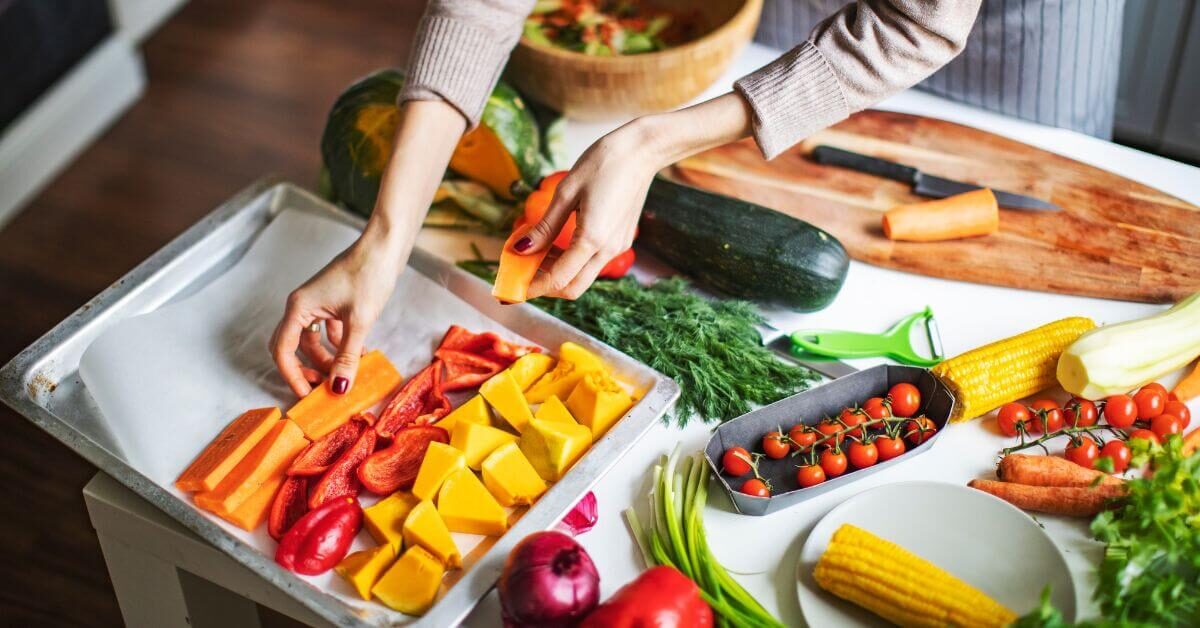

Whether you’re an experienced chef or completely new to cooking for a whole food, plant-based diet, you’re likely to find many instances when recipe substitutions are necessary. Thankfully, there are plenty of substitutions plant-based eaters can make instead of using animal products, added salt, sugar, or oil. If you can master these versatile plant-based ingredients, cooking and baking will be a breeze.
Meat, fish, or poultry: There are many vegan meat substitutes available today, including hotdogs, hamburgers, chicken nuggets, deli meat, and more. We recommend that you stay away from heavily processed fake meat products that contain isolated proteins (i.e., soy protein isolate) and added oils, but there are many other excellent options.
Coarsely ground or mashed beans like chickpeas, white beans, and black beans make a great sandwich and burrito fillings. Adding cooked bulgur to your soups, stews, marinades, tacos, and casseroles gives them a ground meat texture. It absorbs flavors well, so try seasoning it with any flavor. You can use portobello mushrooms and eggplant instead of grilled meats, burgers, or steaks.
Eggs: Chickpea flour makes a good omelet, and aquafaba is a good choice for recipes that call for egg whites, like mousse and meringue. Try skillet-cooked crumbled tofu with spices and vegetables to create a “scrambled-like” egg substitute. In dishes where eggs are usually used for binding, you can use rolled oats, cooked oatmeal, bread crumbs, instant potato flakes, nut butters, or tomato paste.
Milk: There are many varieties and flavors of non-dairy milks made from soy, rice, almond, hemp, etc. Read the label and choose products with no added sugar or oils.
Cheese: There are many cheese substitutes made from soy, rice, almond, hemp, and other ingredients. We recommend that you stay away from heavily processed “fake cheese” products that contain isolated proteins (i.e., soy protein isolate) and added oils. In some recipes, you can also use tofu, nut butter, or nutritional yeast to add a cheesy flavor. Soaked and blended raw cashews are helpful for the creamy/cheesy part of plant-based dishes. Finally, you can use miso, tamari, or tahini to replace cheese-flavored ingredients.
Sugar, honey, or other sweeteners: When it comes to a whole food plant-based lifestyle, refined sugars, like high fructose corn syrup and white sugar, are off the table. These are heavily processed and devoid of nutrients and fiber. Go for whole food sources of sugar like date sugar, date paste or syrup, dried fruits, fruit purées like unsweetened applesauce, and mashed bananas. (To make date paste, just blend 1 cup of pitted dates with 1 cup of water until smooth.)
Butter, Shortening, Fats and Oils: You can use vegetable stocks, water, or other liquids for sautéing or frying. When preparing salad dressings, use a base of vegetable stock, water, or vinegar instead of oil.
When fats and oils are called for in baking recipes, one of the best substitutes is date paste or unsweetened applesauce. Puréed pumpkin, bananas, and other fruits will work in some recipes, but they can change the flavor of the finished product.
Salt: There are many granulated spices you can use instead of salt to season your meal, such as onion, parsley, and garlic. Other substitutes include fresh onion, garlic, lemon juice, salsa, and hot sauces. Several salt substitutes on the market do not contain salt. Choose low-sodium soy sauce or tamari in recipes that call for them.

Meat Substitutes
- Legumes
- Beans, peas, and lentils are high-fiber protein sources that you can easily use as a main course or instead of meat in recipes.
- Veggie Burgers
- Made from various plant foods, including beans, vegetables, and grains.
- Tempeh
- Made from fermented soybeans, tempeh has a meaty texture that can be used instead of ground meat; it works well in curries, chilis, and stir-fries.
- Tofu
- Made from soybeans, tofu has a mild taste and absorbs the flavor of any recipe.
- Portobello Mushrooms
- With a savory flavor, mushrooms can be used in place of grilled meats, burgers, or steaks.

Dairy Substitutes
- Milk
- Unsweetened almond, oat, hemp, soy, hazelnut, or rice milk.
- Cream
- Soymilk, coconut milk, mashed potatoes, pureed garbanzo beans, aquafaba (liquid from canned beans), soaked and blended cashews, puréed tofu
- Cheese
- Nutritional yeast, soaked and blended cashews or almonds, puréed tofu, or miso. You can also use store-bought brands with no added oils or protein isolates.
- Buttermilk
- Mix 1 teaspoon apple cider vinegar or lemon juice with 1 cup of non-dairy milk.
- Yogurt
- Unsweetened, non-dairy varieties.
- Ice Cream
- Place frozen fruit like bananas and strawberries with a few dates and a bit of liquid in the blender for “nice cream.”

Egg Substitutes
- Baking—1 egg is equal to:
- ¼ cup silken tofu blended
1 tbsp ground flaxseed meal + 3 tbsp water
½ mashed banana
¼ cup applesauce or puréed fruit
¼ cup cooked oats
½ cup unsweetened non-dairy yogurt - Cooking—1 egg is equal to:
- ¼ cup mashed potato or sweet potato
¼ cup cooked oats
2-3 tbsp. tomato paste
½ cup unsweetened non-dairy yogurt - Scrambled eggs
- Skillet-cooked crumbled tofu with spices and vegetables
- Egg Whites
- Use Aquafaba (the liquid from canned chickpeas)

Oil Substitutes
- Sautéing
- Water, vegetable broth, or vinegar.
- Baking
- Unsweetened applesauce, puréed pumpkin, bananas and other fruit, date paste.
- Salad Dressings
- Vinegar, low-sodium soy sauce, and lemon juice can all be used as bases for dressings.
Pick out of a few of your favorite recipes and try just one substitution at a time until you find the right combination for you and your family. Remember…be creative and experiment. Keep your taste buds and thoughts open as you create and enjoy new delicious plant-based meals!
Copyright 2025 Center for Nutrition Studies. All rights reserved.
Deepen Your Knowledge With Our
Plant-Based Nutrition
Certificate
Plant-Based Nutrition Certificate
- 23,000+ students
- 100% online, learn at your own pace
- No prerequisites
- Continuing education credits



